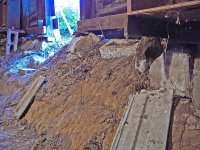Egon, Wayne,
Trouble is, the whole farmhouse is in this condition. The living space looks decent, but it was built cheap 90 years ago and has had nothing but patching since. I recall helping Dad patch stuff that looked this bad 40 years ago when he inherited it in similar condition.
Must say I have been there. The house we live in is over 200 years old and was built by a person that was granted the land as long as he would put in a saw mill to cut lumber for homes in our town. This was an up and down water driven saw. The house was an expanded cape style house with the main house being 11/2 stories and then extended out to include the summer and winter kitchens, down into a workshop and then into the cattle barn.
The total length of the place from front side of house to back side of the barn was over 135 feet. The first project I did was to jack up the north side of the cape and install a corner beam and lower sill. I had help doing this but we had support structures on both sidewalls, supports going to the roof, multiple jack points along the sill area and ended up cutting out the old sill and end post. Actually a sawyer in town cut the end beam and sill to size prior to us removing the old stuff. This project took four weeks from start to finish. So it can be done, but it aint a bunch of fun!
All the systems - plumbing, electric (added years after the farmhouse was built), windows, insulation (none), roof ( I re-roofed it when I inherited it to halt major ongoing water damage), drainage (I fixed that immediately, to halt the driveway from funnelling into that crawl space - that's the tractor connection!), and whatever else you can think of was in near-unusable condition when I inherited it. If you try to open a window there are only a couple that will slide up, others crumble as you apply force.
As for the plumbing I think this is something that you will have to look into replacing. I am sure if the pipes are rusting away there is no way it can be used safely. don't drink the water!
Electrical is also a matter that you will have to replace as some point and if you are going to restore / save the place then putting in a new updated service and limited wiring is something you might have to do soon.
Now you are getting into money when you start talking windows, doors, wiring, plumbing, heck lifting the place will be cheap compared to the other items. But, all good structures start with a good foundation!
Dad used it as a summer home and always said he didn't expect the house to outlast him. He strongly recommended tearing it down instead of trying to revive it. I'm torn between getting by, as he did, because I love the place as-is and it isn't my primary home, and giving up and building new.
For now I'm the third generation trying to slap patch upon patch. I don't think jacking it up is an option. That would break every rusty pipe in the building. It'm not exaggerating, I've repaired seven rusted-out plumbing leaks in the past seven years plus fixed at least that many for Dad in the preceding years. Pulling a building permit would surely lead to a condemnation instead.
I think you should seek help with deciding what to do first. I am sure there are people that could come and look at the structure and let you know what the cost would be to construct a sound foundation under the building. We can all suggest doing things, but the proof is to actually do the work. Gosh we could all meet out there and help with the repairs. Give This Old House a call maybe they are looking for a major project. Their first project, many years ago, included jacking and replacing a foundation on a colonial home in Concord, MA!
This is simply an attempt to continue using a structure that is far beyond its useful life, in all respects - because I love it here. We spend our time outdoors - the house isn't the focal point. We have a decent house in the city to return to when it rains so hard here that water is coming out of the light fixtures.
I could afford to replace the building but for now I prefer to not spend my retirement savings building something new, sterile, unfamiliar. If I ever decide to make the ranch my primary home, that would be the point I would face the decision to rebuild. I would probably go ahead at that time.
Back to my question - has anyone remedied (or delayed) erosion like this?
How?
